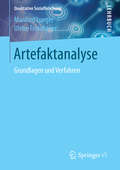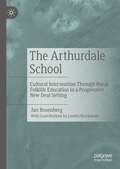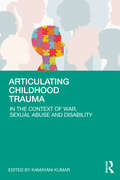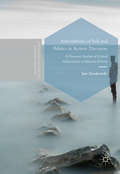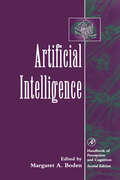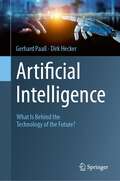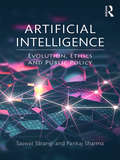- Table View
- List View
Arte Ambientale, Urban Space, and Participatory Art (Routledge Advances in Art and Visual Studies)
by Martina TangaWorking in 1970s Italy, a group of artists—namely Ugo La Pietra, Maurizio Nannucci, Francesco Somaini, Mauro Staccioli, Franco Summa, and Franco Vaccari—sought new spaces to create and exhibit art. Looking beyond the gallery, they generated sculptural, conceptual, and participatory interventions, called Arte Ambientale (Environmental Art), situated in the city streets. Their experiments emerged at a time of cultural crisis, when fierce domestic terrorism aggravated an already fragile political situation. To confront the malaise, these artists embraced a position of artistic autonomy and social critique, democratically connecting the city's inhabitants through direct art practices.
Arte Ambientale, Urban Space, and Participatory Art (Routledge Advances in Art and Visual Studies)
by Martina TangaWorking in 1970s Italy, a group of artists—namely Ugo La Pietra, Maurizio Nannucci, Francesco Somaini, Mauro Staccioli, Franco Summa, and Franco Vaccari—sought new spaces to create and exhibit art. Looking beyond the gallery, they generated sculptural, conceptual, and participatory interventions, called Arte Ambientale (Environmental Art), situated in the city streets. Their experiments emerged at a time of cultural crisis, when fierce domestic terrorism aggravated an already fragile political situation. To confront the malaise, these artists embraced a position of artistic autonomy and social critique, democratically connecting the city's inhabitants through direct art practices.
The Artefacts of Digital Mental Health (Health, Technology and Society)
by Jacinthe FloreThe Artefacts of Digital Mental Health focuses on smartphone apps, wearables devices, and ingestible sensors, which are at the centre of research, development, and investment in mental health and digitalisation. The book aims to examine digital mental health through three artefacts that are defined by their ubiquity, everydayness, popularity, innovation and hype, and emergent qualities. It engages with theoretical approaches to technology, mental health, and wellbeing informed by Science and Technology Studies, sociological studies of health and mental health, and sociomaterialism. The book brings together different theories of mental health, subjectivity, the body, care, and digitalisation alongside biodigital artefacts as exemplars of transformations in digital mental health.
Artefaktanalyse: Grundlagen und Verfahren (Qualitative Sozialforschung)
by Manfred Lueger Ulrike FroschauerDer vorliegende Band zeigt, wie man Artefakte systematisch analysieren und ihr Erkenntnispotential für ein tieferes Verständnis von Gesellschaft nutzen kann. Im Zentrum stehen die Grundfragen der Artefaktanalyse, nämlich warum und wie Gegenstände von wem und mit welchen Folgen für die Menschen und ihr Zusammenleben hergestellt wurden. Für die Sozialwissenschaften erschließt diese Methode ein in unserer Gesellschaft omnipräsentes Material und untersucht es in seiner Bedeutung für alltägliche Handlungsweisen sowie für die Konstitution unserer Umwelt.
Arthur Sullivan: A Victorian Musician (Routledge Revivals)
by Arthur JacobsPublished in 1992. This is a revised, enlarged edition of a book which on its original appearance in 1984 was hailed as a landmark in the study of Victorian musical life. It presents the figure of Sir Arthur Sullivan (1842-1990) not only as the celebrated co-creator of light operas with W.S Gilbert, but as a composer of all kinds of music from symphony and concerto to ballads such as ‘The Lost Chord’ and hymns such as ‘Onward, Christian Soldiers’. A prominent public life, with a knighthood in 1883, is contrasted with an unconventional private life involving a liaison of almost thirty years with an American living in London, Mary Frances Ronalds. The author’s access to Sullivan’s diary held by Yale University and to letters and other documents at the Pierpont Morgan library in New York gives this book both a unique authority and a deep human understanding. A new chapter updates research to the 150th anniversary of the composer’s birth, 1992, and incorporates music examples.
Arthur Sullivan: A Victorian Musician (Routledge Revivals)
by Arthur JacobsPublished in 1992. This is a revised, enlarged edition of a book which on its original appearance in 1984 was hailed as a landmark in the study of Victorian musical life. It presents the figure of Sir Arthur Sullivan (1842-1990) not only as the celebrated co-creator of light operas with W.S Gilbert, but as a composer of all kinds of music from symphony and concerto to ballads such as ‘The Lost Chord’ and hymns such as ‘Onward, Christian Soldiers’. A prominent public life, with a knighthood in 1883, is contrasted with an unconventional private life involving a liaison of almost thirty years with an American living in London, Mary Frances Ronalds. The author’s access to Sullivan’s diary held by Yale University and to letters and other documents at the Pierpont Morgan library in New York gives this book both a unique authority and a deep human understanding. A new chapter updates research to the 150th anniversary of the composer’s birth, 1992, and incorporates music examples.
The Arthurdale School: Cultural Intervention Through Rural Folklife Education in a Progressive New Deal Setting
by Jan RosenbergThis book chronicles the school envisioned by Eleanor Roosevelt in 1933 to serve Arthurdale, the New Deal government-created community in north-central West Virginia. Arthurdale was founded to house unemployed miners and their families and provide them with opportunities to receive healthcare and obtain gainful employment. Roosevelt had a particular interest in the education of children, feeling that education and social life were profoundly intertwined within a community. With that in mind, in 1934, she hired Elsie Ripley Clapp—an educator and leader in the Progressive Education movement—to design and implement the school, as well as oversee the social life of Arthurdale as a whole. In addition to covering the Arthurdale School's birth, life, and dissolution, Rosenberg discusses how the lessons of the school might serve the culture of education today, especially as an element of a comprehensive approach to community revitalization.
Articulating Childhood Trauma: In the Context of War, Sexual Abuse and Disability
by Kamayani KumarThe volume addresses the pertinent need to examine childhood trauma revolving around themes of war, sexual abuse, and disability. Drawing narratives from spatial, temporal, and cultural contexts, the book analyses how conflict, abuse, domestic violence, contours of gender construction, and narratives of ableism affect a child’s transactions with society. While exploring complex manifestations of children’s experience of trauma, the volume seeks to understand the issues related to translatability/representation, of trauma bearing in mind the fact that children often lack the language to express their sense of loss. The book in its study of childhood trauma does a close exegesis of select literary pieces, drawings done by children, memoirs, and graphic narratives.Academicians and research scholars from the disciplines of childhood studies, trauma studies, resilience studies, visual studies, gender studies, cultural studies, disability studies, and film studies stand to benefit from this volume. The ideas that have been expressed in this volume will richly contribute towards further research and scholarship in this domain.
Articulating Childhood Trauma: In the Context of War, Sexual Abuse and Disability
The volume addresses the pertinent need to examine childhood trauma revolving around themes of war, sexual abuse, and disability. Drawing narratives from spatial, temporal, and cultural contexts, the book analyses how conflict, abuse, domestic violence, contours of gender construction, and narratives of ableism affect a child’s transactions with society. While exploring complex manifestations of children’s experience of trauma, the volume seeks to understand the issues related to translatability/representation, of trauma bearing in mind the fact that children often lack the language to express their sense of loss. The book in its study of childhood trauma does a close exegesis of select literary pieces, drawings done by children, memoirs, and graphic narratives.Academicians and research scholars from the disciplines of childhood studies, trauma studies, resilience studies, visual studies, gender studies, cultural studies, disability studies, and film studies stand to benefit from this volume. The ideas that have been expressed in this volume will richly contribute towards further research and scholarship in this domain.
Articulating The Global And The Local: Globalization And Cultural Studies (Cultural Studies Series: Politics And Culture Ser. #No. 5)
by Ann CvetkovichThis book explores how discourses of the local, the particular, the everyday, and the situated are being transformed by new discourses of globalization and transnationalism, as used both by government and business and in critical academic discourse. Unlike other studies that have focused on the politics and economics of globalization, Articulating the Global and the Local highlights the importance of culture and provides models for a cultural studies that addresses globalization and the dialectic of local and global forces. Arguing for the inseparability of global and local analysis, the book demonstrates how global forces enter into local situations and how in turn global relations are articulated through local events, identities, and cultures; it includes studies of a wide range of cultural forms including sports, poetry, pedagogy, ecology, dance, cities, and democracy. Articulating the Global and the Local makes the ambitious claim that the category of the local transforms the debate about globalization by redefining what counts as global culture. Central to the essays are the new global and translocal cultures and identities created by the diasporic processes of colonialism and decolonization. The essays explore a variety of local, national, and transnational contexts with particular attention to race, ethnicity, gender, and sexuality as categories that force us to rethink globalization itself.
Articulating Intersex: A Crisis at the Intersection of Scientific Facts and Social Ideals (Philosophy and Medicine #131)
by Natalie DelimataThis book explores the ethical dilemma clinicians may face when disclosing a diagnosis of atypical sex. The moment of disclosure reveals an epistemic incompatibility between scientific fact and social meaning in relation to sex. Attempting to assess the bio-psychosocial implications of this dilemma highlights a complex historic antagonism between fact and meaning making satisfactory resolution of this dilemma difficult. Drawing on David Hume, WVO Quine and Michel Foucault the author presents an integrative model, which views scientific fact and social meaning as codetermining threads in one fabric of knowledge. From this epistemic perspective, the ethical dilemma is understood as a tear in the fabric signifying a rupturing of ontological integrity. To mend this tear and resolve the ethical dilemma three metaphysical perspectives are considered: essentialism, naturalism and emergentism. The book’s unique features include: an exploration of the impact of diagnostic disclosure on people with atypical sex (intersex); a synthesis of the epistemic perspectives of social and natural science facilitating interdisciplinary collaboration; a critical evaluation of three metaphysical perspectives on atypical sex (intersex); the application of Hume’s epistemological and moral distinctions to contemporary biomedicine and bioethics. The book’s target audience includes academics, students and professionals whose work intersects the natural and social sciences, and individuals interested in the metaphysics, epistemology and meta-ethics of sex.
Articulating Novelty in Science and Art: The Comparative Technography of a Robotic Hand and a Media Art Installation
by Julian StubbeJulian Stubbe aims at characterizing what novelty is in the becoming of objects and how the new becomes part of a shared reality. The study’s method is comparative and concerned with technological practice in science as well as in art. It draws on a detailed comparison of two cases: the becoming of a robotic hand made from silicone, and the genesis of a media art installation that renders visible changes in the earth’s magnetic field. In contrast to the canon of sociological innovation studies, which regard novelty as what actors in the field label as new or innovation, the author attempts to delineate certain shifts in an object’s becoming that individuate an object and render its difference visible. This entails attending the enactment of novelty through cultural imaginaries and narratives about technologies, as well as acknowledging the shifts in technical forms that make loose elements enter a new kind of circularity. From this perspective, novelty is an articulation: when differences are not contradicting, but when differing characteristics are aligned, fitted, and click in so as to appear and behave as a distinct entity.
Articulations of Self and Politics in Activist Discourse: A Discourse Analysis of Critical Subjectivities in Minority Debates
by Jan ZienkowskiThis book focuses on the discursive processes that allow activists to make sense of themselves and of the modes of politics they engage in. It shows how political and metadiscursive awareness develop in tandem with a reconfiguration of one’s sense of self. The author offers an integrated pragmatic and poststructuralist perspective on self and subjectivity. He draws on Essex style discourse theory, early pragmatist philosophy, and linguistic pragmatics, arguing for a notion of discourse as a multi-dimensional practice of articulation. Demonstrating the analytical power of this perspective, he puts his approach to work in an analysis of activist discourse on integration and minority issues in Flanders, Belgium. Subjects articulate a whole range of norms, values, identities and narratives to each other when they engage in political discourse. This book offers a way to analyse the logics that structure political awareness and the associated boundaries for discursive self-interpretation.
Articulations of Self and Politics in Activist Discourse: A Discourse Analysis of Critical Subjectivities in Minority Debates
by Jan ZienkowskiThis book focuses on the discursive processes that allow activists to make sense of themselves and of the modes of politics they engage in. It shows how political and metadiscursive awareness develop in tandem with a reconfiguration of one’s sense of self. The author offers an integrated pragmatic and poststructuralist perspective on self and subjectivity. He draws on Essex style discourse theory, early pragmatist philosophy, and linguistic pragmatics, arguing for a notion of discourse as a multi-dimensional practice of articulation. Demonstrating the analytical power of this perspective, he puts his approach to work in an analysis of activist discourse on integration and minority issues in Flanders, Belgium. Subjects articulate a whole range of norms, values, identities and narratives to each other when they engage in political discourse. This book offers a way to analyse the logics that structure political awareness and the associated boundaries for discursive self-interpretation.
Artifacts and Ideas: Essays in Archaeology
by Bruce TriggerPrehistoric archaeologists cannot observe their human subjects nor can they directly access their subjects' ideas. Both must be inferred from the remnants of the material objects they made and used. In recent decades this incontrovertible fact has encouraged partisan approaches to the history and method of archaeology. An empirical discipline emphasizing data, classification, and chronology has given way to a behaviorist approach that interprets finds as products of ecologically adaptive strategies, and to a postmodern alternative that relies on an idealist, cultural-relativist epistemology based on belief and cultural traditions.In Artifacts and Ideas, Bruce G. Trigger challenges all partisan versions of recent developments in archaeology, while remaining committed to understanding the past from a social science perspective. Over 30 years, Trigger has addressed fundamental epistemological issues, and opposed the influence of narrow theoretical and ideological commitments on archaeological interpretation since the 1960s. Trigger encourages a relativistic understanding of archaeological interpretation. Yet as post-processual archaeology, influenced by postmodernism, became increasingly influential, Trigger countered nihilistic subjectivism by laying greater emphasis on how in the long run the constraints of evidence could be expected to produce a more comprehensive and objective understanding of the past.In recent years Trigger has argued that while all human behavior is culturally mediated, the capacity for such mediation has evolved as a flexible and highly efficient means by which humans adapt to a world that exists independently of their will. Trigger agrees that a complete understanding of what has shaped the archaeological record requires knowledge both of past beliefs and of human behavior. He knows also that one must understand humans as organisms with biologically grounded drives, emotions, and means of understanding. Likewise, even in the absence of data supplied in a linguistic format by texts and oral traditions, at least some of the more ecologically adaptive forms of human behavior and some general patterns of belief that display cross-cultural uniformity will be susceptible to archaeological analysis.Advocating a realist epistemology and a materialist ontology, Artifacts and Ideas offers an illuminating guide to the present state of the discipline as well as to how archaeology can best achieve its goals.
Artifacts and Ideas: Essays in Archaeology
by Bruce G. TriggerPrehistoric archaeologists cannot observe their human subjects nor can they directly access their subjects' ideas. Both must be inferred from the remnants of the material objects they made and used. In recent decades this incontrovertible fact has encouraged partisan approaches to the history and method of archaeology. An empirical discipline emphasizing data, classification, and chronology has given way to a behaviorist approach that interprets finds as products of ecologically adaptive strategies, and to a postmodern alternative that relies on an idealist, cultural-relativist epistemology based on belief and cultural traditions.In Artifacts and Ideas, Bruce G. Trigger challenges all partisan versions of recent developments in archaeology, while remaining committed to understanding the past from a social science perspective. Over 30 years, Trigger has addressed fundamental epistemological issues, and opposed the influence of narrow theoretical and ideological commitments on archaeological interpretation since the 1960s. Trigger encourages a relativistic understanding of archaeological interpretation. Yet as post-processual archaeology, influenced by postmodernism, became increasingly influential, Trigger countered nihilistic subjectivism by laying greater emphasis on how in the long run the constraints of evidence could be expected to produce a more comprehensive and objective understanding of the past.In recent years Trigger has argued that while all human behavior is culturally mediated, the capacity for such mediation has evolved as a flexible and highly efficient means by which humans adapt to a world that exists independently of their will. Trigger agrees that a complete understanding of what has shaped the archaeological record requires knowledge both of past beliefs and of human behavior. He knows also that one must understand humans as organisms with biologically grounded drives, emotions, and means of understanding. Likewise, even in the absence of data supplied in a linguistic format by texts and oral traditions, at least some of the more ecologically adaptive forms of human behavior and some general patterns of belief that display cross-cultural uniformity will be susceptible to archaeological analysis.Advocating a realist epistemology and a materialist ontology, Artifacts and Ideas offers an illuminating guide to the present state of the discipline as well as to how archaeology can best achieve its goals.
Artificial General Intelligence: 14th International Conference, AGI 2021, Palo Alto, CA, USA, October 15–18, 2021, Proceedings (Lecture Notes in Computer Science #13154)
by Ben Goertzel Alexey Potapov Matthew IkléThis book constitutes the refereed proceedings of the 14th International Conference on Artificial General Intelligence, AGI 2021, held as a hybrid event in San Francisco, CA, USA, in October 2021.The 36 full papers presented in this book were carefully reviewed and selected from 50 submissions. The papers cover topics from foundations of AGI, to AGI approaches and AGI ethics, to the roles of systems biology, goal generation, and learning systems, and so much more.
Artificial Intelligence (Handbook Of Perception And Cognition)
by Margaret A. BodenArtificial Intelligence is the study of how to build or program computers to enable them to do what minds can do. This volume discusses the ways in which computational ideas and computer modeling can aid our understanding of human and animal minds. Major theoretical approaches are outlined, as well as some promising recent developments. Fundamental philosophical questions are discussed along with topics such as: the differences between symbolic and connectionist AI, planning and problem solving, knowledge representation, learning, expert systems, vision, natural language, creativity, and human-computer interaction. This volume is suitable for any psychologist, philosopher, or computer scientist wanting to know the current state of the art in this area of cognitive science.Up-to-date account of how computational ideas and techniques are relevant to psychologyIncludes discussions of "classical" (symbolic) AI, of connectionism (neural nets), of evolutionary programming, and of A-LifeDiscusses a wide range of psychology from low-level vision to creativity
Artificial Intelligence: Second CAAI International Conference, CICAI 2022, Beijing, China, August 27–28, 2022, Revised Selected Papers, Part I (Lecture Notes in Computer Science #13604)
by Lu Fang Daniel Povey Guangtao Zhai Tao Mei Ruiping WangThis three-volume set LNCS 13604-13606 constitutes revised selected papers presented at the Second CAAI International Conference on Artificial Intelligence, held in Beijing, China, in August 2022. CICAI is a summit forum in the field of artificial intelligence and the 2022 forum was hosted by Chinese Association for Artificial Intelligence (CAAI).The 164 papers were thoroughly reviewed and selected from 521 submissions. CICAI aims to establish a global platform for international academic exchange, promote advanced research in AI and its affiliated disciplines such as machine learning, computer vision, natural language, processing, and data mining, amongst others.
Artificial Intelligence: Second CAAI International Conference, CICAI 2022, Beijing, China, August 27–28, 2022, Revised Selected Papers, Part II (Lecture Notes in Computer Science #13605)
by Lu Fang Daniel Povey Guangtao Zhai Tao Mei Ruiping WangThis three-volume set LNCS 13604-13606 constitutes revised selected papers presented at the Second CAAI International Conference on Artificial Intelligence, held in Beijing, China, in August 2022. CICAI is a summit forum in the field of artificial intelligence and the 2022 forum was hosted by Chinese Association for Artificial Intelligence (CAAI). The 164 papers were thoroughly reviewed and selected from 521 submissions. CICAI aims to establish a global platform for international academic exchange, promote advanced research in AI and its affiliated disciplines such as machine learning, computer vision, natural language, processing, and data mining, amongst others.
Artificial Intelligence: 19th Russian Conference, RCAI 2021, Taganrog, Russia, October 11–16, 2021, Proceedings (Lecture Notes in Computer Science #12948)
by Sergei M. Kovalev Sergei O. Kuznetsov Aleksandr I. PanovThis book constitutes the proceedings of the 19th Russian Conference on Artificial Intelligence, RCAI 2021, held in Moscow, Russia, in October 2021. The 19 full papers and 7 short papers presented in this volume were carefully reviewed and selected from 80 submissions. The conference deals with a wide range of topics, categorized into the following topical headings: cognitive research; data mining, machine learning, classification; knowledge engineering; multi-agent systems and robotics; natural language processing; fuzzy models and soft computer; intelligent systems; and tools for designing intelligent systems.
Artificial Intelligence: 18th Russian Conference, RCAI 2020, Moscow, Russia, October 10–16, 2020, Proceedings (Lecture Notes in Computer Science #12412)
by Sergei O. Kuznetsov Aleksandr I. Panov Konstantin S. YakovlevThis book constitutes the proceedings of the 18th Russian Conference on Artificial Intelligence, RCAI 2020, held in Moscow, Russia, in October 2020. The 27 full papers and 8 short papers presented in this volume were carefully reviewed and selected from 140 submissions. The conference deals with a wide range of topics, including data mining and knowledge discovery, text mining, reasoning, decisionmaking, natural language processing, vision, intelligent robotics, multi-agent systems,machine learning, AI in applied systems, and ontology engineering.
Artificial Intelligence: What Is Behind the Technology of the Future?
by Gerhard Paaß Dirk HeckerArtificial Intelligence (AI) is already present in our daily routines, and in the future, we will encounter it in almost every aspect of life – from analyzing X-rays for medical diagnosis, driving autonomous cars, maintaining complex machinery, to drafting essays on environmental problems and drawing imaginative pictures. The potentials of AI are enormous, while at the same time many myths, uncertainties and challenges circulate that need to be tackled. The English translation of the book “Künstliche Intelligenz – Was steckt hinter der Technologie der Zukunft?” originally published in German (Springer Vieweg, 2020), this book is addressed to the general public, from interested citizens to corporate executives who want to develop a better and deeper understanding of AI technologies and assess their consequences. Mathematical basics, terminology, and methods are explained in understandable language. Adaptations to different media such as images, text, and speech and the corresponding generative models are introduced. A concluding discussion of opportunities and challenges helps readers evaluate new developments, demystify them, and assess their relevance for the future.
Artificial Intelligence: Evolution, Ethics and Public Policy
by Saswat Sarangi Pankaj SharmaWhat will the future be? A dystopian landscape controlled by machines or a brave new world full of possibilities? Perhaps the answer lies with Artificial Intelligence (AI)—a phenomenon much beyond technology that has, continues to, and will shape lives in ways we do not understand yet. This book traces the evolution of AI in contemporary history. It analyses how AI is primarily being driven by "capital" as the only "factor of production" and its consequences for the global political economy. It further explores the dystopian prospect of mass unemployment by AI and takes up the ethical aspects of AI and its possible use in undermining natural and fundamental rights. A tract for the times, this volume will be a major intervention in an area that is heavily debated but rarely understood. It will be essential reading for researchers and students of digital humanities, politics, economics, science and technology studies, physics, and computer science. It will also be key reading for policy makers, cyber experts and bureaucrats.
Artificial Intelligence: Evolution, Ethics and Public Policy
by Saswat Sarangi Pankaj SharmaWhat will the future be? A dystopian landscape controlled by machines or a brave new world full of possibilities? Perhaps the answer lies with Artificial Intelligence (AI)—a phenomenon much beyond technology that has, continues to, and will shape lives in ways we do not understand yet. This book traces the evolution of AI in contemporary history. It analyses how AI is primarily being driven by "capital" as the only "factor of production" and its consequences for the global political economy. It further explores the dystopian prospect of mass unemployment by AI and takes up the ethical aspects of AI and its possible use in undermining natural and fundamental rights. A tract for the times, this volume will be a major intervention in an area that is heavily debated but rarely understood. It will be essential reading for researchers and students of digital humanities, politics, economics, science and technology studies, physics, and computer science. It will also be key reading for policy makers, cyber experts and bureaucrats.


